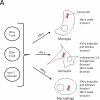Interferon-gamma- and perforin-mediated immune responses for resistance against Toxoplasma gondii in the brain
- PMID: 22005272
- PMCID: PMC3372998
- DOI: 10.1017/S1462399411002018
Interferon-gamma- and perforin-mediated immune responses for resistance against Toxoplasma gondii in the brain
Abstract
Toxoplasma gondii is an obligate intracellular protozoan parasite that causes various diseases, including lymphadenitis, congenital infection of fetuses and life-threatening toxoplasmic encephalitis in immunocompromised individuals. Interferon-gamma (IFN-γ)-mediated immune responses are essential for controlling tachyzoite proliferation during both acute acquired infection and reactivation of infection in the brain. Both CD4+ and CD8+ T cells produce this cytokine in response to infection, although the latter has more potent protective activity. IFN-γ can activate microglia, astrocytes and macrophages, and these activated cells control the proliferation of tachyzoites using different molecules, depending on cell type and host species. IFN-γ also has a crucial role in the recruitment of T cells into the brain after infection by inducing expression of the adhesion molecule VCAM-1 on cerebrovascular endothelial cells, and chemokines such as CXCL9, CXCL10 and CCL5. A recent study showed that CD8+ T cells are able to remove T. gondii cysts, which represent the stage of the parasite in chronic infection, from the brain through their perforin-mediated activity. Thus, the resistance to cerebral infection with T. gondii requires a coordinated network using both IFN-γ- and perforin-mediated immune responses. Elucidating how these two protective mechanisms function and collaborate in the brain against T. gondii will be crucial in developing a new method to prevent and eradicate this parasitic infection.
Figures



Similar articles
-
The immune system utilizes two distinct effector mechanisms of T cells depending on two different life cycle stages of a single pathogen, Toxoplasma gondii, to control its cerebral infection.Parasitol Int. 2020 Jun;76:102030. doi: 10.1016/j.parint.2019.102030. Epub 2019 Nov 25. Parasitol Int. 2020. PMID: 31778800 Free PMC article. Review.
-
Microglia produce IFN-gamma independently from T cells during acute toxoplasmosis in the brain.J Interferon Cytokine Res. 2007 Jul;27(7):599-605. doi: 10.1089/jir.2006.0157. J Interferon Cytokine Res. 2007. PMID: 17651021
-
VCAM-1/α4β1 integrin interaction is crucial for prompt recruitment of immune T cells into the brain during the early stage of reactivation of chronic infection with Toxoplasma gondii to prevent toxoplasmic encephalitis.Infect Immun. 2014 Jul;82(7):2826-39. doi: 10.1128/IAI.01494-13. Epub 2014 Apr 21. Infect Immun. 2014. PMID: 24752515 Free PMC article.
-
Gamma interferon production, but not perforin-mediated cytolytic activity, of T cells is required for prevention of toxoplasmic encephalitis in BALB/c mice genetically resistant to the disease.Infect Immun. 2004 Aug;72(8):4432-8. doi: 10.1128/IAI.72.8.4432-4438.2004. Infect Immun. 2004. PMID: 15271900 Free PMC article.
-
Host resistance in the brain against Toxoplasma gondii.J Infect Dis. 2002 Feb 15;185 Suppl 1:S58-65. doi: 10.1086/337999. J Infect Dis. 2002. PMID: 11865441 Review.
Cited by
-
Astrocytes: Integrative Regulators of Neuroinflammation in Stroke and Other Neurological Diseases.Neurotherapeutics. 2016 Oct;13(4):685-701. doi: 10.1007/s13311-016-0477-8. Neurotherapeutics. 2016. PMID: 27677607 Free PMC article. Review.
-
Microglial STAT1-sufficiency is required for resistance to toxoplasmic encephalitis.PLoS Pathog. 2022 Sep 6;18(9):e1010637. doi: 10.1371/journal.ppat.1010637. eCollection 2022 Sep. PLoS Pathog. 2022. PMID: 36067217 Free PMC article.
-
PD-L1, TIM-3, and CTLA-4 Blockade Fails To Promote Resistance to Secondary Infection with Virulent Strains of Toxoplasma gondii.Infect Immun. 2018 Aug 22;86(9):e00459-18. doi: 10.1128/IAI.00459-18. Print 2018 Sep. Infect Immun. 2018. PMID: 29967089 Free PMC article.
-
Effect of HIV aspartyl protease inhibitors on experimental infection with a cystogenic Me49 strain of Toxoplasma gondii.Pathog Glob Health. 2022 Mar;116(2):107-118. doi: 10.1080/20477724.2021.1967628. Epub 2021 Aug 22. Pathog Glob Health. 2022. PMID: 34420500 Free PMC article.
-
Brains and Brawn: Toxoplasma Infections of the Central Nervous System and Skeletal Muscle.Trends Parasitol. 2017 Jul;33(7):519-531. doi: 10.1016/j.pt.2017.04.001. Epub 2017 May 5. Trends Parasitol. 2017. PMID: 28483381 Free PMC article. Review.
References
-
- McCabe RE, Remington JS. Toxoplasma gondii. In: Mandell GL, Douglas RG, Bennett JE, editors. Principles and Practice of Infectious Diseases. Churchill Livingstone Inc.; New York: 1990. 2090.
-
- Suzuki Y, Orellana MA, Schreiber RD, Remington JS. Interferon gamma: the major mediator of resistance against Toxoplasma gondii. Science. 1988;240:516–518. - PubMed
-
- Boyer K, Marcinak J, McLeod R. Toxoplasma gondii (Toxoplasmosis) In: Long S, Pickering LK, Prober CG, editors. In Principles and Practice of Pediatric Infectious Diseases. 3rd edition Churchill Livingstone; New York: 2007.
-
- Israelski DM, Remington JS. Toxoplasmosis in the non-AIDS immunocompromised host. In: Remington JS, Swrltz M, editors. Curr.Clin.Top.Infect.Dis. Blackwell Scientific Publications; London: 1993. pp. 322–356. - PubMed
Publication types
MeSH terms
Substances
Grants and funding
LinkOut - more resources
Full Text Sources
Research Materials
Miscellaneous

